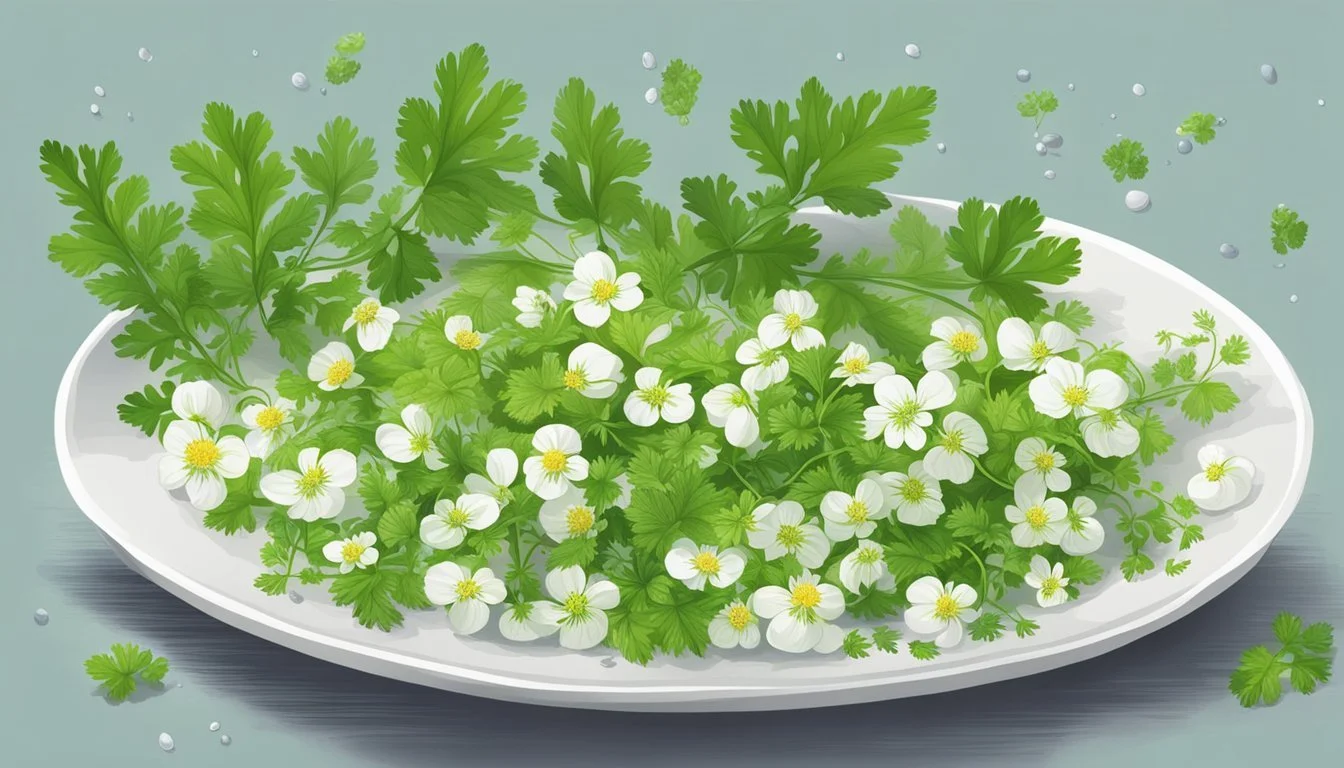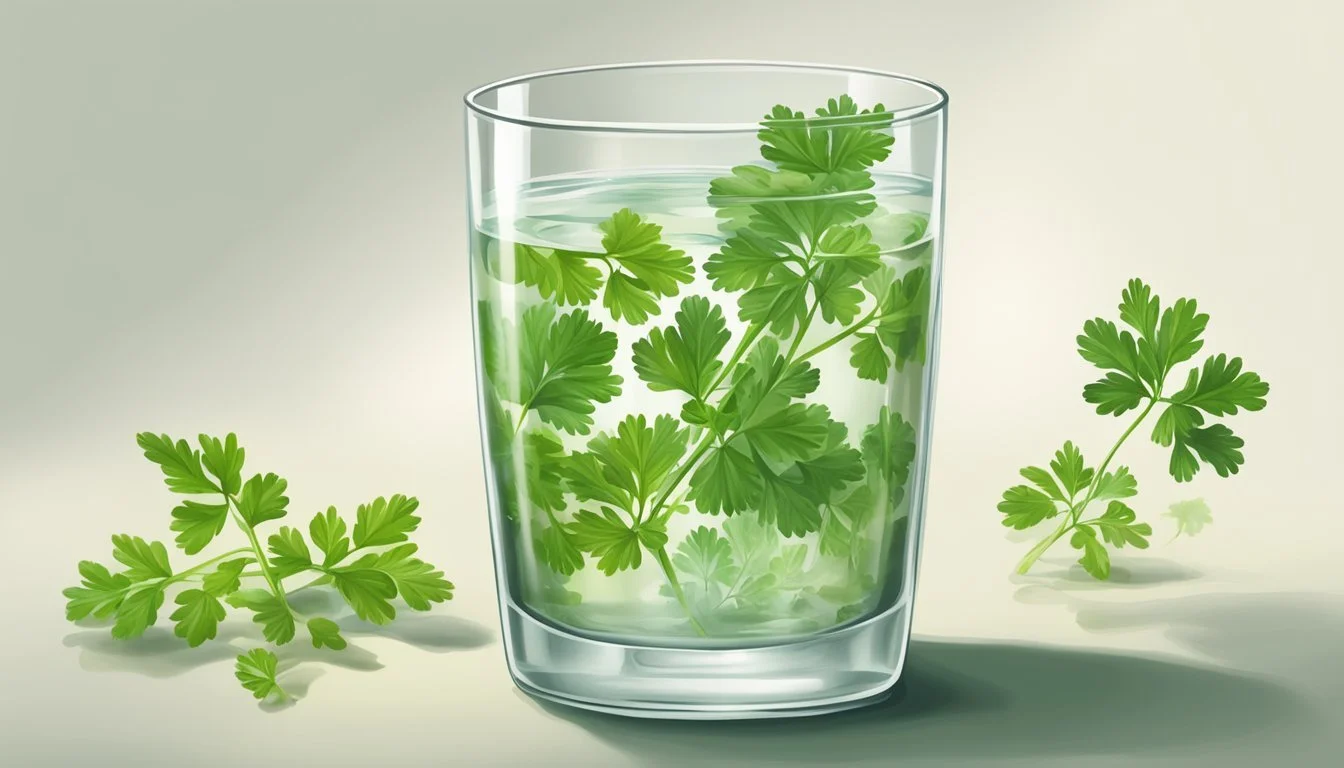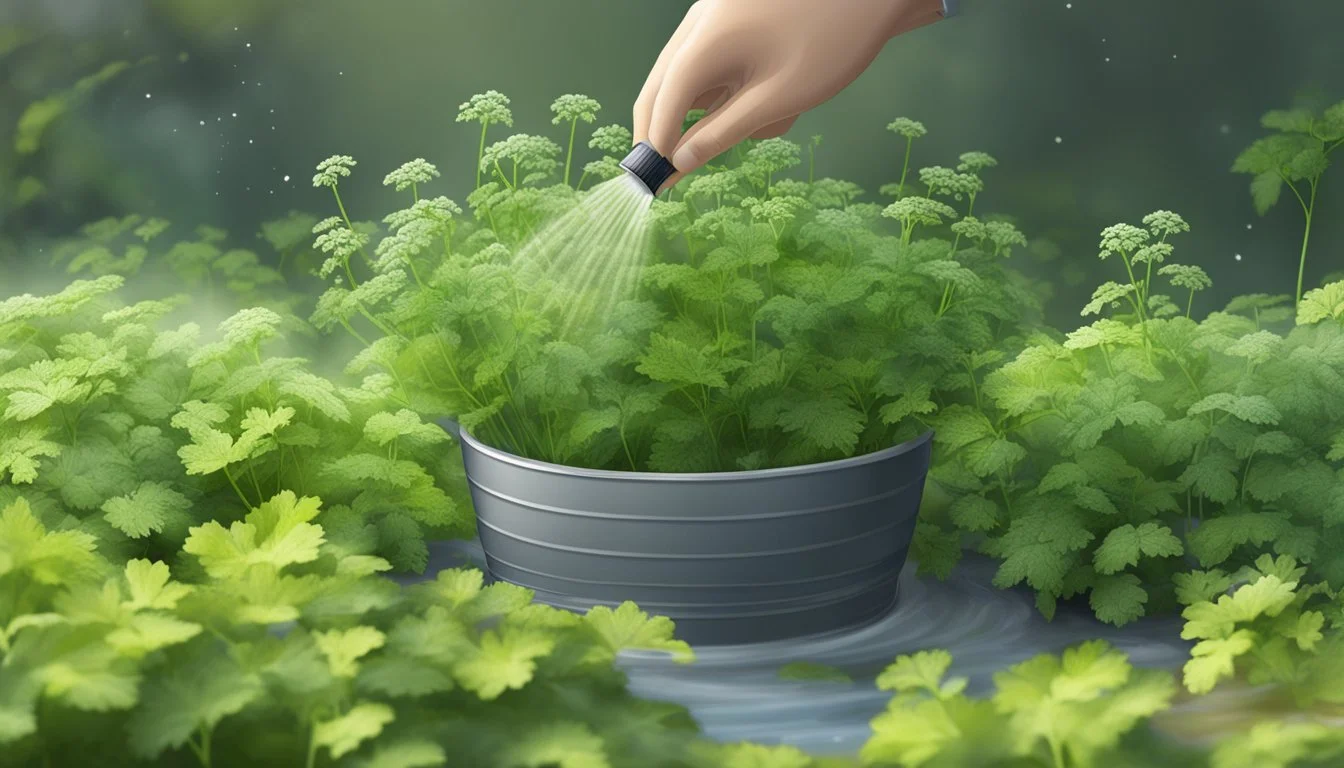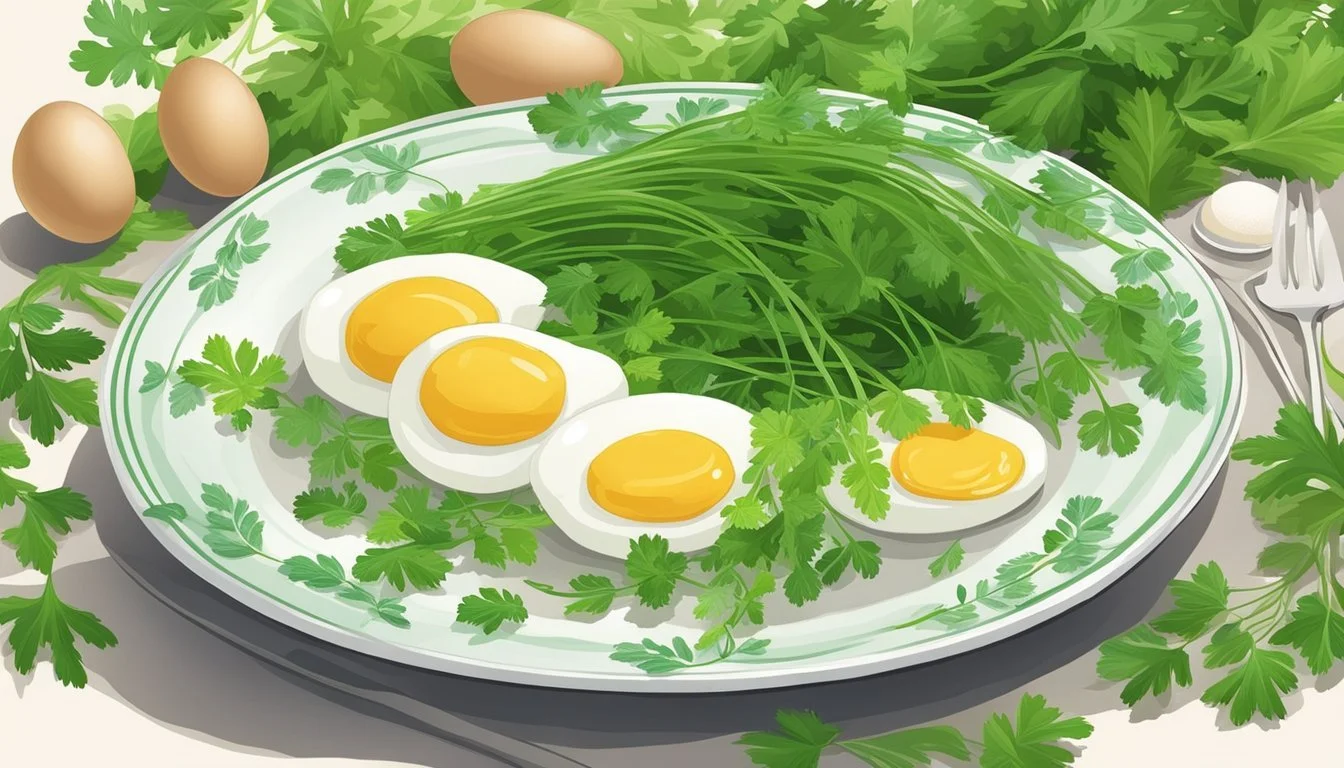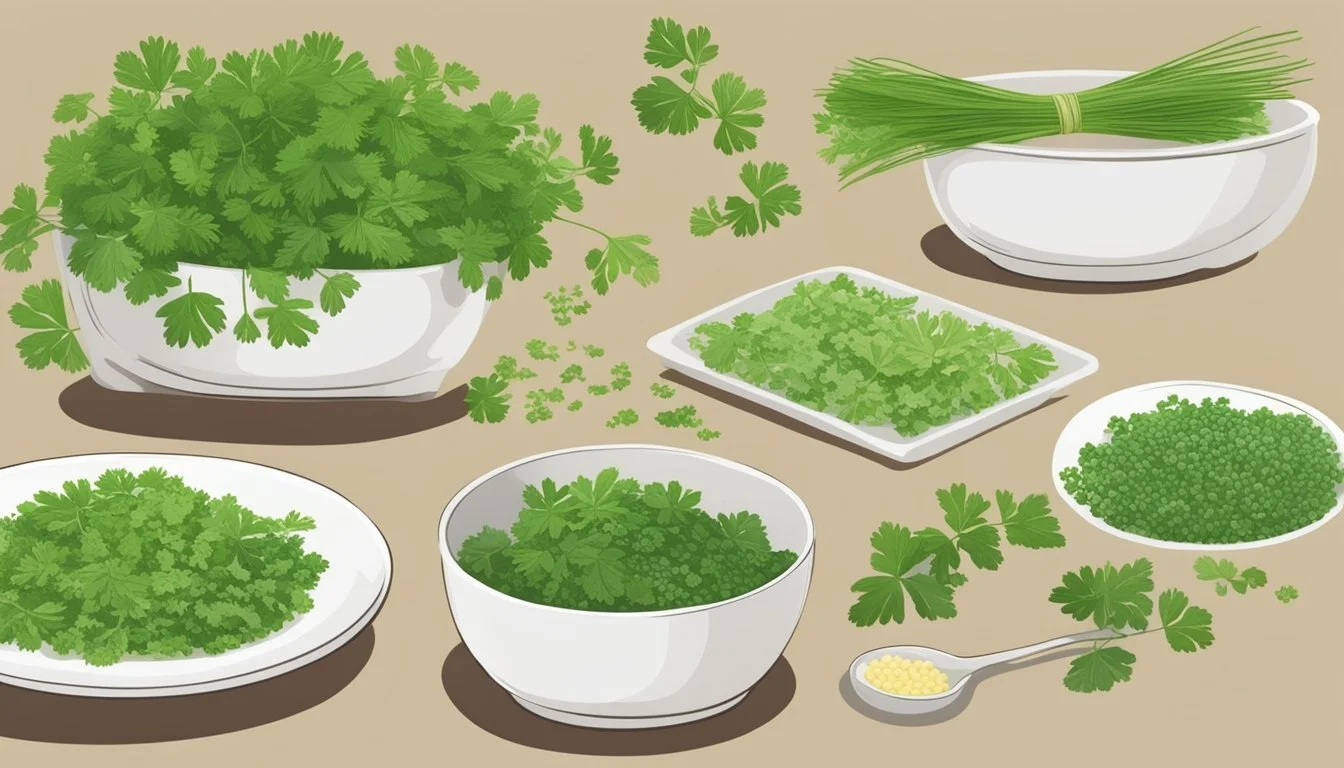Reviving Limp Chervil
Techniques for Crisp Herbs in Culinary Pairings
Chervil, a delicate herb cherished for its gentle flavor, is a staple in the culinary world, especially within French cuisine. Its taste, a subtle blend of parsley and anise, enhances the profile of any dish without overpowering it. Recognized for its contribution to the classic 'fines herbes' mix, chervil is particularly suited to seasoning mild proteins such as fish and chicken, as well as being a traditional complement to egg dishes.
Maintaining the freshness of chervil can be challenging due to its tender nature. Unlike heartier herbs, chervil can wilt and lose its lively character quite quickly. To combat the natural tendency of chervil to become limp, there are effective methods to revive its crispness. Keeping chervil vibrant not only preserves its aesthetic appeal but also ensures the maximum expression of its flavor when incorporated into recipes.
Incorporating crisp chervil into various dishes elevates the taste experience. Whether it's folded into a soft scramble or laid atop a freshly baked fish, the herb infuses meals with its characteristic light and slightly peppery essence. Knowing how to revive and maintain the delicate structure of chervil is key for chefs and home cooks alike who wish to utilize its unique flavor to the fullest.
Understanding Chervil
Chervil plays a delicate yet pivotal role in culinary applications, most notably within the fines herbes blend of French cuisine. Its unique flavor and historical significance offer depth to both cooking and cultural traditions.
Botanical Profile
Chervil, also known by the Latin name Anthriscus cerefolium, is an annual herb in the Apiaceae family, related to parsley and tarragon. It thrives in temperate climates and typically grows to a height of 12 to 24 inches. Chervil's lace-like leaves resemble those of French parsley, a testament to its place within the same botanical family.
Culinary Uses
Regarded as one of the essential herbs in the traditional fines herbes blend, chervil's culinary uses are varied. It imparts a mild flavor with hints of licorice or anise, making it especially suitable for flavoring eggs, fish dishes, salads, and sauces. While chervil can be used fresh, its flavor tends to diminish when dried.
Fresh Chervil: Ideal for garnishes, infusion in vinegars, or incorporation into soft cheeses (What wine goes well with soft cheeses?)
Cooked with Foods: Typically added towards the end of cooking to preserve its delicate flavor
Flavor Characteristics
Chervil's flavor profile is subtle with anise-like undertones, often drawing comparisons to tarragon, though it is milder and with a slight hint of licorice. This delicate flavor makes it much more versatile than stronger aromatic herbs, enabling it to complement rather than overwhelm other ingredients.
Aroma: Light and mild, reminiscent of anise
Taste: Slight sweetness with a clean, light anise flavor
Historical Significance
Chervil's history can be traced back to the Romans and Greeks, who utilized it not only for its culinary talents but also for purported medicinal properties. Throughout the ages, chervil has remained a staple in French cooking, solidifying its status within the renowned fines herbes ensemble along with parsley, tarragon, and chives.
Cultivating Chervil
Chervil thrives in cool temperatures and moist soil conditions, making it an accessible herb for gardeners to grow for its delicate flavor used in culinary dishes.
Optimal Growing Conditions
Chervil prefers cool temperatures and grows best in partial shade, protecting it from the intense heat of the midday sun. It's often sown directly into the garden as it does not tolerate being transplanted well.
For sowing chervil seeds:
Planting depth: Sow seeds ¼ inch deep.
Spacing: Place seeds about 3 inches apart initially and thin the plants to 8 to 12 inches as they grow.
Soil requirements: Chervil seeds should be planted in a bed of very fine soil or covered lightly with fine vermiculite to encourage even germination.
Plant Care and Maintenance
Once chervil is established, it requires consistent care to maintain healthy growth and ensure optimal flavor:
Watering: Keep the soil moist without waterlogging the plant.
Soil: Chervil benefits from rich, moist soil; adding organic matter can help retain necessary moisture.
Harvesting: To harvest, snip fresh chervil leaves as needed, taking care not to remove more than a third of the plant at one time. This can be done when the plants are between 3 to 4 inches tall.
Containers: If space is limited, chervil can also be grown in pots. Ensure sufficient drainage and consistent moisture for the best results.
By following these tips, gardeners can easily grow fresh chervil to enhance a variety of dishes, from eggs to fish, with a subtle hint of anise flavor.
Harvesting and Preserving
When harvesting and preserving chervil, one needs to employ techniques that maintain its delicate flavor and freshness. The goal is to ensure that whether the chervil is used immediately or stored for later use, it retains the quality that defines its culinary contributions.
Harvesting Techniques
Optimal Timing: Harvest chervil in the cool hours of the morning when its essential oils are at their peak.
Technique: Use clean, sharp scissors to snip the stems gently, choosing the outer leaves first and allowing the inner ones to mature.
Frequency: Regular harvesting can encourage a fuller plant, so gather sprigs every week.
Preservation Methods
Refrigeration:
Wrap the stems in a damp paper towel and store them in a plastic bag in the refrigerator. This can retain freshness for about a week.
For long-term storage, finely chop the chervil and mix it with water before freezing in an ice cube tray.
Spread out the chervil sprigs in a single layer on a drying rack and allow to air dry, away from direct sunlight.
Once dried, store the herb in an airtight container away from heat, which can preserve it for up to a year.
Making use of these methods, one can keep chervil from grocery stores or farmers' markets robust and flavorful for varied culinary uses, particularly with eggs and fish where its delicate nature is most appreciated.
Chervil in Cooking
Chervil brings a mild anise flavor and a hint of parsley to dishes, especially in French cuisine where its finesse is appreciated. It demands careful handling to preserve its delicate nature, especially regarding cooking time and pairing with other flavors.
Incorporating in Dishes
Chervil's fragile flavor is best preserved when added towards the end of the cooking process. It shines in French egg dishes, such as omelets and scrambled eggs, where it can be gently folded in just before serving. In soups or sauces, chervil should be sprinkled in after the heat is turned off to avoid wilting and flavor loss.
Sauces: A key component in Béarnaise and fines herbes, chervil pairs with cream or butter bases to create a rich, yet light, taste.
Salads: Fresh chervil leaves add a vibrant taste and visual appeal to green salads.
Seafood: Its subtlety complements the inherent flavors of various fish and shellfish. (What wine goes well with shellfish?)
Pairing with Other Ingredients
Bold flavors can easily overpower chervil, so it is ideally used alongside more gently flavored ingredients. In traditional French cuisine, chervil is part of the delicate fines herbes blend, together with tarragon, chives, and parsley.
Eggs: Aromatic consistency is achieved when chervil is mingled with eggs.
Seafood: Lean fish and tender seafood benefit from chervil's light touch.
Vinaigrettes: For dressings, chervil infused in a vinaigrette harmonizes well with a mild olive oil base.
Substitutes and Complements
While unique, chervil can be substituted by several other herbs if unavailable. Parsley or tarragon are the closest matches, and a pinch of anise seed can mimic chervil's faint licorice taste.
Tarragon: Offers a similar anise flavor but is more potent.
Parsley: Provides a similar green freshness that complements many of the same dishes.
Dill and Cilantro: While not direct substitutes, can be used where a hint of freshness is needed.
Chervil's role in the kitchen extends beyond taste to include visual garnishes and subtle flavor enhancements. This understated herb plays a pivotal role when a dish requires a touch of culinary finesse.
Nutritional Benefits
Chervil is not merely a flavor enhancer for culinary creations; it plays a significant role in contributing to a nutritious diet. This delicate herb provides a variety of vitamins and minerals essential for maintaining good health.
Vitamins and Minerals
Vitamin A: Chervil offers a modest amount of vitamin A, which is crucial for maintaining healthy vision and immune function.
Vitamin C: The presence of vitamin C in chervil helps protect the body against immune system deficiencies and cardiovascular disease.
Minerals: A diverse array of minerals can be found in chervil, including:
Mineral Role in the Body Calcium Essential for bone health and muscle function. Potassium Helps in regulating blood pressure and heart rate. Iron Vital for blood production and oxygen transport. Magnesium Supports muscle and nerve function, blood glucose control. Selenium Plays a role in metabolism and thyroid function.
Antioxidants: Chervil contains antioxidants that help combat inflammation and protect the body's cells from damage.
Diuretic Properties: It may act as a diuretic, potentially aiding in the reduction of excess fluids and may contribute to managing blood pressure levels.
By incorporating chervil into their diet, individuals can gain the nutritional benefits of its vitamins, minerals, and antioxidants while enjoying its unique flavor in various dishes, particularly those with eggs and fish.
Gourmet Recipes
In this section, readers will discover refined recipes that feature chervil, highlighting its role in classical French cuisine and creative culinary applications.
Classical French Dishes
Fines Herbes Omelette: A staple in French cooking, the omelette is transformed with the fines herbes blend—a combination of chervil, parsley, tarragon, and chives. Chervil's light anise flavor enriches egg dishes such as this classic omelette, bringing a fresh, herby taste that complements the creamy texture.
Ingredients: Eggs, chervil, parsley, tarragon, chives, butter, salt, pepper.
Steps: Whisk eggs; mix in finely chopped herbs. Cook in butter until just set; fold and serve immediately.
Béarnaise Sauce with Herbes de Provence: Chervil is integral to Béarnaise sauce, a derivative of hollandaise. Infused with herbes de Provence, it pairs excellently with fish and poultry, offering a creamy, tangy complement to the dish's main protein.
Ingredients: Butter, egg yolks, white wine vinegar, chervil, tarragon, shallots, peppercorns, herbes de Provence.
Steps: Combine vinegar, herbs, shallots, and peppercorns; reduce. Strain and whisk into egg yolks; emulsify with butter.
Creative Herb Infusions
Chervil and Asparagus Quiche: Elevate the classic quiche with a chervil-infused custard, pouring it over blanched asparagus and Gruyère cheese. The quiche offers a harmonious blend of flavors with the chervil enhancing the vegetable's natural sweetness.
Ingredients: Pie crust, eggs, cream, Gruyère cheese, asparagus, chervil.
Steps: Pre-bake crust; layer cheese and asparagus. Pour chervil-egg mixture; bake until set.
Chervil Compound Butter for Vegetables: A versatile garnish for vegetables such as carrots and potatoes, chervil compound butter adds a subtle aniseed twist that complements the natural flavors of the vegetables.
Ingredients: Unsalted butter, chervil, lemon zest, salt.
Steps: Soften butter; mix in finely chopped chervil and lemon zest. Roll in parchment; chill until firm. Slice to serve on warm vegetables.

